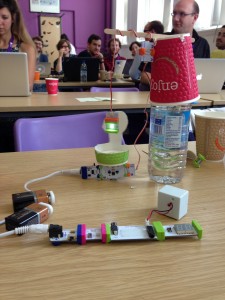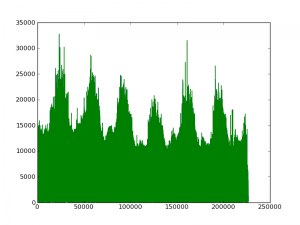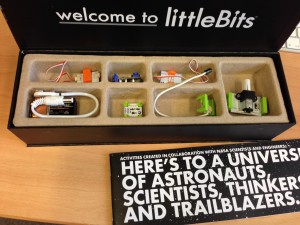This blog is a cross posting from Dark Matter Sheep blog by Edward Gomez.
This week I have been at the National Astronomy Meeting in Portsmouth. There have been many great talks and I particularly enjoyed organising the “Engaging the public and schools with astronomy” session with the famous Jen Gupta.
Wednesday was Hack Day (sponsored by GitHub and .Astronomy). I always enjoy hack days because I rarely have the opportunity of engaging in a little blue skies coding.
I brought along a cute circuit kit called LittleBits with the aim of doing not very much coding but hacking in a more hands on way. LittleBits are magnetic, modular circuit board kits, primarily for kids but really for anyone who is curious about doing fun things with electronics. The nice people at LittleBits were kind enough to send me their “Space kit” to play with.
I was very pleased to have the awesome (not like a hot dog) Rob Simpson express an interest in playing with this kit. We spend a good 10 minutes clipping these modules together and making farty noises with the speaker and light sensor. Then we got serious with the hacking.
Little-bits exoplanet tranistor
We wanted to make a model of an exoplanet system. We so we used:
- Motor
- 2 x power packs (including 9V PP3 batteries)
- LED
- light sensor (light dependent resistor)
- speaker
- 2 x connector cables
Other things that we hacked from the room were paper cups, tea stirring sticks, blutack, bottle of water and jelly babies (quite a few of them met with a sticky end). We also had to ‘borrow’ an audio jack
Exoplanets are planets orbiting stars that are not the Sun. Mostly exoplanets are too faint compared to the star their orbit for us to see them directly. One of the ways you can find these are by looking for stars that periodically dim. This suggests that a planet is blocking a bit of the light from its star from us.
Circuit #1 – The exoplanet system
We made a planet and its orbit out of a cup and sat this on a the motor, so it span around nicely.

We used the LED as the star (it would have been more faithful if it had been like a ball, shining in all directions but you get the point). We then suspended this from the stirring stick attached to the top of the water bottle, over the top of the spinning planet.
Circuit #2 – The astronomer
To find these exoplanets astronomers point telescopes at them and take regular measurements of their star’s brightness. This is what we did with our Little-Bits.
We made a circuit out of a power pack, light sensor, speaker and LCD (also known as the Laser Display Board, for fans for I’m Sorry I haven’t a Clue).
Pointing our ‘telescope’ (light sensor) towards the ‘star’ (LED), we can see how the brightness changes when the planet (cut from the paper cup) passes in front of it by the value on the Laser Display Board (LCD) decreasing.
We made planets of different sizes too. They should block out more light from the ‘star’ and we wanted to see if we could measure that.
POWER ON
Turn on both circuits and see what happens….
Exoplanet SloMo video
[You’ll have to click on the link because Cardiff University doesn’t trust us to put a video on this site…]
You can see in this great little slow-mo video Rob took, that the numbers on the Laser Display Board do decrease when the ‘planet’ passes between the ‘star’ and ‘telescope’ parts of the model.

Rob fed a pure tone or note into the ‘astronomer’ circuit, so we could hear the effect of the exoplanet. The volume of the note should decrease when the planet passes in front of the star. [WARNING: there is a graph coming]
The graph (of volume against time) shows peaks where the planet is behind the star and troughs where the planet is blocking the light. There was a lot of stray light in the room, so its not a perfect graph.
In the picture above you can see we made 4 exoplanet solar systems with different size planets (one included 2 planets!).
Conclusion
I can highly recommend these LittleBits kits (the one we are using here is the space kit). They are very adaptible and loads of fun, especially for jaded astronomers like us. Playing with circuits, paper, scissors and Rob was just what I needed to get my astronomy mojo back 🙂






